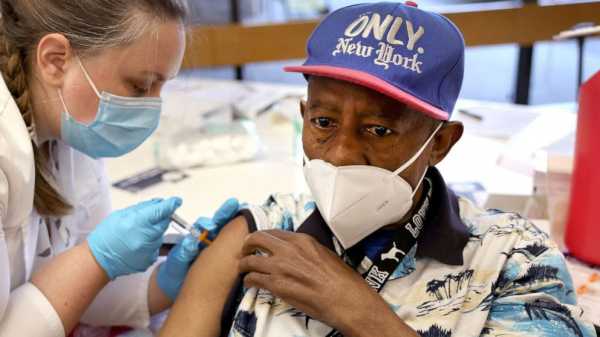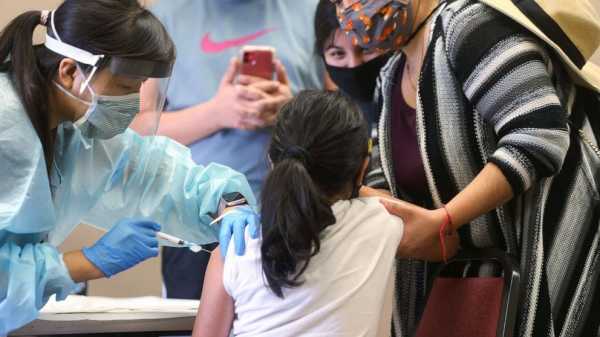A surge in pediatric patients with respiratory illnesses is overwhelming hospitals across the United States, as experts warn of a potentially severe flu season in the coming months.
Pediatric bed capacity in hospitals is the highest it has been in two years. Around the country, hospitals are being inundated with pediatric patients sick with respiratory illnesses filling up to 71% of the estimated 40,000 available hospital beds, the U.S. Department of Health and Human Services reports.
"[Various respiratory] viruses are all in play on top of SARS-CoV-2, and now the increasing amounts of influenza, which we had feared was coming in like a lion this year, has arrived," Dr. Charlotte Hobbs, professor of pediatric infectious disease and microbiology at the University of Mississippi Medical Center (UMMC), Children's of Mississippi, told ABC News.

A person gets an influenza vaccine from a pharmacist during an event hosted by the Chicago Department of Public Health on Sept. 9, 2022 in Chicago.Scott Olson/Getty Images, FILE
Dr. Michael Koster, the director of pediatric infectious diseases at Hasbro Children's Hospital in Providence, Rhode Island, says from mid-September to mid-October the number of young patients admitted into the hospital with respiratory syncytial virus (RSV), a common respiratory virus that usually causes cold-like symptoms, doubled.
"We are seeing patients coming from over 100 miles away, because their local pediatric hospital is full or has closed," Koster told ABC News, referencing the recent closing of several pediatric hospitals in New England.
Lynnette Brammer, an epidemiologist in the influenza division at the CDC, says the national public health agency is monitoring the influx of respiratory viruses circulating.
The CDC is reporting early increases in seasonal influenza activity in most of the United States, with the southeast and south-central areas of the country reporting the highest levels of activity.
MORE: Why are pediatric hospitals filling to capacity?
Experts say that the rise may be fueled, in part, by the softening of COVID restrictions, leaving many vulnerable to sickness as a potentially severe flu season approaches.
"We've had reasonably quiet years as a result of all the efforts to control COVID. It means that there is a resurgence of some of these viruses that we have annually, but in a more significant way," said John Brownstein, Ph.D., an ABC News medical contributor and chief innovation officer at Boston Children's Hospital.
The transition to the winter months also typically sees an uptake in illnesses.
"As the weather becomes drier, people return inside, spend more time inside. And you layer that with a lot of population mobility, especially as the holidays come up, that becomes a real, perfect storm for the spread of flu," Brownstein said.
Just last week, 1,674 patients were admitted to the hospital with flu complications, according to the CDC. This increased from 1,332 the week prior, the agency says.
MORE: Black, Hispanic adults more likely to be hospitalized with flu than white adults
Brownstein notes that we see a lot of variability year-to-year, but that this current flu season has been a very rapid rise and hasn't peaked yet.
"Usually, we see increases in flu start maybe in November or December. Normally, the peak happens in February, but we went into October already seeing increases in influenza activity," Brammer said.
Visits to health care providers are currently concentrated in younger people with the greatest percentage of visits for flu-like illness are for those under 5 years old at more than 10%, CDC data shows. The next highest percentage is 5 to 24-year-olds, at 5% of visits.
"A lot of years you do have influenza activity, start in children and then spread to the other age groups," Brammer said.

A child receives the flu vaccination shot from a nurse at a free clinic held at a local library on Oct. 14, 2020 in Lakewood, Calif.Mario Tama/Getty Images, FILE
Puerto Rico, Louisiana, and Alabama joined New York, Washington, D.C., Texas, Georgia, Tennessee, and South Carolina in reporting high levels of flu-like illness last week, according to the CDC. At this time last year, Texas, Georgia and D.C were the only states to report similar levels.
"CDC is following our surveillance data so that we can keep people informed about influenza activity, promoting [the] influenza vaccine, and letting people know that this is the time of year to go ahead and get your flu vaccine," Brammer said.
MORE: Flu cases on the rise as US prepares for possibly severe season, data shows
Brammer notes the importance of antivirals to combat flu. However, "those medications really need to be taken in the first couple of days of illness. So, you need to see your doctor quickly," she adds.
The CDC recommends that everyone ages 6 months and older get a flu vaccine to help prevent infection and severe illness.
"It's really simple. We have a safe and effective vaccine. If you haven't gotten that vaccine yet, it's time to do so. You really want to get it ahead of Halloween," Brownstein said.
"Of course, it's never too late to do so. But the sooner the better," he adds.
Sourse: abcnews.go.com






